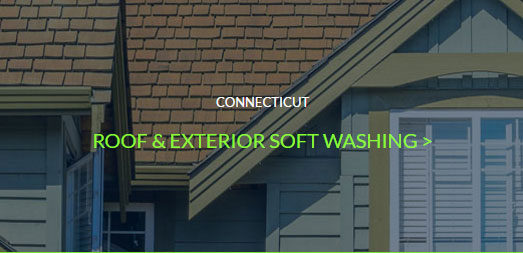Soft Washing FAQ
Traditional pressure washing or power washing, just blasts away the top layer infestation, never really solving the issue of infection and never really offering a long lasting option or solution. Pressure and or power washing can also accelerate aging on building surfaces and actually make the problem worse over time. The pressure washers can spread the infestation and push the bacteria deeper into the surface later causing streaking. Using high pressure on roofing shingles can easily cause extreme damage. In most cases this voids the manufactures warranty.
Instead of Pressure Washing, we apply the Soft Wash cleaning solution that is 100% biodegradable using a low pressure application. This treatment will last 4-6 times longer than traditional pressure washing and won’t cause damage to your roof or existing surfaces. This is a special blend mixed specifically to the needs of your cleaning project. This process has been approved by roof shingle manufacturers including ARMA (Asphalt Roofing ManufacturersAssociation). The “Soft Wash” process is also recommended by many insurance companies.
The amount of time it takes will depend on the size of your home and roof surface. Generally we can apply the treatment to your roof in less than 4 hours.
No. We use state of the art truck mounted sprayer systems that will supply enough pressure to apply our soft wash solution onto your roof from a ladder or the ground. (There may be a special circumstances where roof access is need.)
Yes. We ask that you notify the Estimator of any sensitive/important plants.
1 day before – we suggest you water all plants vegetation in the immediate work area.
Service Day – Please make sure that all doors and windows are closed securely. Keep all pets inside. Be sure and your vehicles, potted plants grills etc are away from the house or in the garage. We also need running water from an exterior water spigot(s). We ask that you check them in advanced and be sure they are turned on and in good working order.
On average the results last around 3 years, but depends on the weather and your particular home & location.
The streaks that are staining the roof are actually a bacteria called Gleocapsa Magma. This is the main culprit for most of the roof staining throughout the US. There are a few more culprits that also grow up on roofs making a mess of things. Roof top organisims like mildew and algae are unsightly but not as destructive as some of the more aggressive bacterias and fungus. Moss and Lichens also abound and are the final bad actors that show up after the party has been started by the fungal growths. These algae, molds, mildews, bacterias, lychens and mosses directly decompose and break down roofing materials.
Much of the organisms on a roof are there because of the warm, moist environment a roof creates, especially on the north and west sides of a roof. Micro organisms populate in an abundance growing so well that they begin to be noticeable to the human eye. Many roofing surfaces are made with materials that can be metabolized by the micro organisms. Shingles now contain limestone as a filler mixed into the aggregate of the shingle. Many of the algae, mildew and bacteria’s utilize this limestone as the base nutrient of their roof ecosystem and begin to feed on it.
The good news is that these stains / micro organisms can be safely removed using our Soft Wash Technology.
Yes. The life span of your roof can be decreased by as much as 50%. The number one reason for premature roof failure is algae. Lichen and moss have a deeper root system that will set into the roofing materials and remove the protective ganules from the shingles causing your roof to be replaced prematurely.
Yes, our ingredients are biodegradable and safe for people, plants and animals.
Chimney FAQ
Yes, we are in the service business. We are here to keep your chimney in good working order.
Yes, we do all aspects of fireplace building and repairs. Our team is made up of experts that specialize in masonry repairs, sweeps, liners, and other services that go along with maintaining your fireplace.
These stains are a sign of water damage. The white staining is called efflorescence. They generally appear when too much water has penetrated the chimney crown, mortar joints and the brick. In some cases the heating system condensates and causes excess water inside the chimney, which causes it to be prematurely saturated. This by-product of the exhaust contributes to premature deterioration of your chimney. One way to correct this is by adding a chimney liner. Our service professionals will guide you with making the proper repairs to your chimney.
In most cases we can remove efflorescence. If your chimney is left unrepaired there is a good chance it will return.
Yes, we carry a large variety of stainless steel caps in both our service trucks and warehouse to fit most chimneys. Copper and powder coated caps & chase covers are also available.




